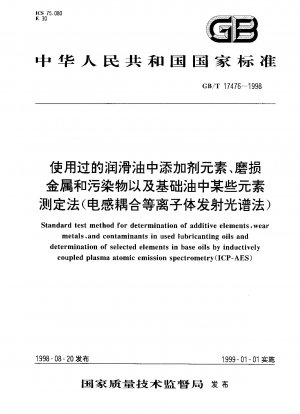GB/T 17476-1998
Standard test method for determination of additive elements, wear metals, and contaminants in used lubricanting oils and determination of selected elements in base oils by inductively coupled plasma atomic emission spectrometry (ICP-AES) (English Version)
- Standard No.
- GB/T 17476-1998
- Language
- Chinese, Available in English version
- Release Date
- 1998
- Published By
- General Administration of Quality Supervision, Inspection and Quarantine of the People‘s Republic of China
- Status
- 2023-09
- Replace By
- GB/T 17476-2023
- Latest
- GB/T 17476-2023
- Scope
- This standard specifies the determination of additive elements, wear metals and contaminants in used lubricating oils, and the content of various selected metal elements in base oils or regenerated base oils by inductively coupled plasma emission spectrometry (ICP-AES). The determined elements are listed in Table 1 (including aluminum, boron, barium, calcium, chromium, copper, iron, lead, magnesium, manganese, molybdenum, nickel, phosphorus, potassium, sodium, silicon, tin, silver, sulfur, titanium , vanadium and zinc a total of 22 elements). This standard is applicable to the determination of oil-soluble metals, and does not mean that insoluble metal particles can be quantitatively determined or detected. The analysis results depend on the particle size. When the metal particles are larger than several microns, the measurement results will be low , but the application of this standard can quickly provide information on mechanical wear and lubricant usage status. When the concentration of metal elements in the oil exceeds the upper limit of the standard curve, an appropriate amount of diluent can be added for measurement after dilution, which will not reduce the measurement accuracy of the method. In order to determine sulfur, the instrument is required to have a vacuum system and an inert gas purification optical path. For some instruments, if the spectral wavelength range is limited, it is impossible to measure sodium and potassium. Except for calcium, sulfur and zinc in Table 2 and Table 4 of this standard, the lower concentration limits listed for other elements are estimated based on the standard deviation of 10 times repeatability. For the lower concentration limits of elements calcium, sulfur and zinc, it is indicated The lowest concentration tested between individual research laboratories. This standard deals with certain hazardous materials, operations and equipment, but it is not intended to make recommendations on all safety issues related thereto. Therefore, users should establish appropriate safety and protective measures and determine the applicable management system before using this standard.
GB/T 17476-1998 history
- 2023 GB/T 17476-2023 Determination of Multiple Elements in Lubricating Oils and Base Oils by Inductively Coupled Plasma Emission Spectrometry
- 1998 GB/T 17476-1998 Standard test method for determination of additive elements, wear metals, and contaminants in used lubricanting oils and determination of selected elements in base oils by inductively coupled plasma atomic emission spectrometry (ICP-AES)
